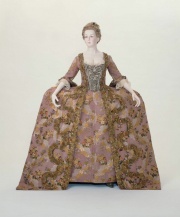Difference between revisions of "Taffeta"
Jump to navigation
Jump to search
| Line 1: | Line 1: | ||
[[File:77.6a-b-E581CR-d1.jpg|thumb|'''MFA Acc. #:''' 77.6a-b]] | [[File:77.6a-b-E581CR-d1.jpg|thumb|'''MFA Acc. #:''' 77.6a-b]] | ||
| + | [[File:MFA 521770 Taffeta dress.jpg|thumb|Quaker taffeta dress<br>MFA# 52.1770]] | ||
== Description == | == Description == | ||
| Line 11: | Line 12: | ||
<gallery> | <gallery> | ||
| + | File:MFA521204 Taffeta apron.jpg|Taffeta apron<br>MFA# 52.1204 | ||
| + | File:MFA502372 Taffeta bag.jpg|Silk taffeta bag<br>MFA# 50.372 | ||
| + | File:MFA50490 Taffeta shoes.jpg|Silk taffeta shoes<br>MFA# 50.490 | ||
File:Image3_802547.jpg|Acetate taffeta | File:Image3_802547.jpg|Acetate taffeta | ||
</gallery> | </gallery> | ||
Revision as of 09:25, 21 October 2020
Description
A crisp, shiny fabric originally made from Silk in Persia. Taffeta is now also made from Cotton, Rayon, or Nylon. The plain weave fabric uses a filling yarn that is heavier than the warp to produce a fine cross-rib texture. Taffeta is used for linings, dresses, suits, and trim.
Synonyms and Related Terms
taffety; tafetán (Esp.)
Additional Images
Resources and Citations
- Hoechst Celanese Corporation, Dictionary of Fiber & Textile Technology (older version called Man-made Fiber and Textile Dictionary, 1965), Hoechst Celanese Corporation, Charlotte NC, 1990
- Edward Reich, Carlton J. Siegler, Consumer Goods: How to Know and Use Them, American Book Company, New York City, 1937
- Hermann Kuhn, Conservation and Restoration of Works of Art and Antiquities, Butterworths, London, 1986
- Susan E. Schur, Conservation Terminology: A review of Past & Current Nomenclature of Materials, Technology and Conservation, Spring (p.34-39); Summer (p.35-38); Fall (p.25-36), 1985
- Wikipedia: http://en.wikipedia.org/wiki/Taffeta (Accessed Nov. 9, 2005)
- Art and Architecture Thesaurus Online, http://www.getty.edu/research/tools/vocabulary/aat/, J. Paul Getty Trust, Los Angeles, 2000





